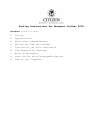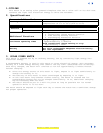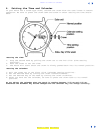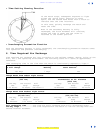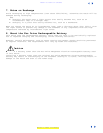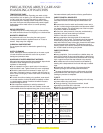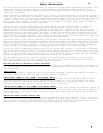
Marking Marking Water-resistant
on the Dial on the characteristics
Caseback
Face washing, Swimming Skin diving Scuba diving
splashes, (diving (diving with
sweat, without air tanks)
raindrops, etc. air tanks)
Non water-resistant
NONE NONE NO NO NO NO watch and must be kept
away from water.
An ordinary water-resistant
NONE WATER OK NO NO NO watch and can withstand
RESIST splashes, sweat, rain-drops
and etc. for daily life use.
WR100M WATER For frequent use with
WR10bar RESIST OK OK OK NO water. It is not specially
WR150M designed for scuba diving.
For skin and scuba diving.
WR200M WATER OK OK OK OK Usable up to the respective
RESIST indicated depths.
See instruction book for further information
TEMPERATURE CARE
Avoid temperature extremes. Exposing your watch to high
temperatures, such as placing it on the dashboard of a vehicle
or use in a hot tub, may cause the watch to malfunction,
shorten battery life or damage certain components. Leaving
the watch in extreme cold temperatures may cause irregular
timekeeping until the watch returns to normal operating
temperature.
SHOCK-RESISTANT
The watch may be worn while playing golf or other activities,
but avoid severe shocks such as dropping it on a hard surface.
MAGNETIC-RESISTANT
No problem should occur from using the watch around
ordinary household electric appliances such as TV sets or
stereos. Keep away from magnets.
CHEMICAL/GAS RESISTANT
Do not expose the watch to chemicals or gases for long
periods.
WATCH CLEANING
Stains, waterspots and accumulated dirt on the case, crystal
or band should be removed with a soft cloth to prevent
damage and premature wear.
HANDLING OF WATER-RESISTANT WATCHES
Although water-resistant watches are warranted, steps should
be taken to avoid damage that may result from
accidents or mishandling:
■
Do not operate the crown or push-button in the water or
while the watch is wet. Tighten screw lock crown completely.
■
Should the watch become immersed in water, dry it off
right away. If the watch comes in contact with salt water, be
sure to rinse it thoroughly in warm fresh water to remove any
trace of salt.
■
If a watch is wet from cleaning or by accident, never store it
in a closed container. It should be dried immediately or taken
to a watchmaker or jeweler if moisture is inside the case to
prevent damage from rust.
■
Vital components necessary to resist the entrance of
moisture deteriorate with time and use. Gaskets, crowns and
other materials should be replaced every year or two to ensure
PRECAUTIONS ABOUT CARE AND
HANDLING OF WATCHES
that water resistant quality remains at factory specifications.
CARE FOR METAL BRACELETS
To extend the life and maintain the good appearance of the
metal watch bracelet, the following recommendations are
given:
■
Be aware that since the watch and bracelet is worn next to
the skin, it collects dust and perspiration and becomes soiled if
not cleaned regularly. This is particularly true of the inner parts
of the links or mesh of the bracelet.
■
Soil and rust, when present in a bracelet, are dissolved by
perspiration and can cause staining of cuffs and
irritation of the skin in some instances.
■
Heavy perspiration should be wiped off the watch and
bracelet with a soft dry cloth. The bracelet should be cleaned
occasionally by using an old toothbrush and warm soapy
water after which the soap is thoroughly rinsed with clear water
and the bracelet dried completely. The foregoing manner of
cleaning should not be done if the watch is not water-resistant
but should instead be done by your jeweler.
CARE FOR STRAPS
LEATHER
■
Heavy perspiration, if not removed from a leather strap, can
wash out the natural oils and cause the leather to become dry
and deteriorate. Any moisture should be blotted with a soft dry
cloth or paper towel and the strap allowed to dry naturally.
■
Salt residue and soil can be removed from the leather by
cleaning with a dampened soft cloth and mild soap or saddle
soap.
■
Occasionally, the inside surface of the strap should be
cleaned by using a soft cloth dampened with alcohol.
■
The strap should always be worn a little loosely (one finger
space between wrist and strap) to allow air to circulate thus
causing any moisture to evaporate.
RUBBER
■
Rubber straps should be washed frequently with mild soap
and warm water using a soft brush.
■
Thorough cleaning, using the same method, should
especially be done after use in salt water.
■
Solvents, oils, perspiration, tanning lotion and salt can cause
rubber to deteriorate if not removed.
Return to Table of Contents
Return to Table of Contents



